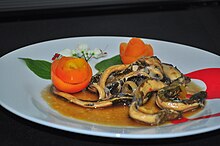Linarang
 Linarang na bakasi, made with little morays | |
| Alternative names | nilarang, larang, gilarang |
|---|---|
| Course | Main course |
| Place of origin | Philippines |
| Region or state | Central Visayas |
| Serving temperature | Hot |
| Main ingredients | fish, garlic, tomato, red onion, fermented black beans, unripe mangoes or bilimbi, chilis, coconut milk |
Linarang, also known as larang or nilarang, is a Filipino fish stew originating from the Central Visayas islands. It is made with fish in a spicy and sour coconut milk-based broth with garlic, red onions, tomatoes, fermented black beans (tausi), chilis, and sour fruits.[1]
Etymology
The name linarang or nilarang (lit. "done as larang"), is the affixed form of the Cebuano verb larang, meaning "to stew with coconut milk and spices".[2] The word is originally a synonym of the ginataan cooking process (ginat-an or tinunoan in Cebuano), but has come to refer exclusively to this particular dish.[3]
Description
Linarang is prepared by first sautéing the fish with garlic, red onions, and tomatoes. It is then added to a broth with fermented black beans (tausi), chilis, and a souring agent. The souring agent is usually bilimbi (iba), unripe mangoes, or tamarind (sambag), but can also be any sour fruit.[4][5][6]
Variations
Linarang can vary depending on the type of fish used. The most commonly used are porcupinefish (tagotongan), stingrays (pagi), barracuda (rompe), triggerfish (pakol, pugot, and tikos), marlin (malasugui), snakehead (tasik), parrotfish (molmol or isda sa bato), and Spanish mackerel (tanguigue).[4][7]
A notable variant from Cordova, Cebu is linarang na bakasi or nilarang bakasi, which is made from moray eels (bakasi); specifically the little moray (Gymnothorax richardsonii), which is abundant in the waters around the municipality. The eels are commonly referred to as "baby eels" in English due to their size, even though they are fully-grown adults.[5][8][9][10]
In popular culture
Linarang was featured on the Netflix TV series, Street Food (TV series) in the Cebu, Philippines episode.[11]
See also
References
- ^ "Larangan sa Pasil – Best Larang". SunStar Best of Cebu 2017. Retrieved April 11, 2019.
- ^ "larang [lá.rang.]". Binisaya. Retrieved April 11, 2019.
- ^ "tinunoan". Binisaya.com. Retrieved April 11, 2019.
- ^ a b "Linarang". My Island Cebu. Retrieved April 11, 2019.
- ^ a b "Larang Bakasi ( Baby Ells ) Sauteed with mix herbs and spices". SparkRecipes. Retrieved April 11, 2019.
- ^ "Bakasi Recipe". Made in Cebu. Retrieved April 11, 2019.
- ^ Fenix, Michaela (2017). Country Cooking: Philippine Regional Cuisines. Anvil Publishing, Incorporated. ISBN 9789712730443.
- ^ Albano, Jhoanna Lou. "Cebu is among the nine cities featured in new Netflix documentary series, 'Street Food'". MSN.com. Retrieved April 11, 2019.
- ^ Padayhag, Michelle Joy L. "Cordova folk hopeful 'bakasi' will survive". Cebu Daily News. Inquirer.net. Retrieved April 11, 2019.
- ^ "Bakasi / Baby Eels". Market Manila. Retrieved April 11, 2019.
- ^ Radovan, Jill Tan. "This New Netflix Show Proves Cebu's Food Scene Isn't All Lechon". Spot. Summit Digital . Retrieved February 28, 2021.

